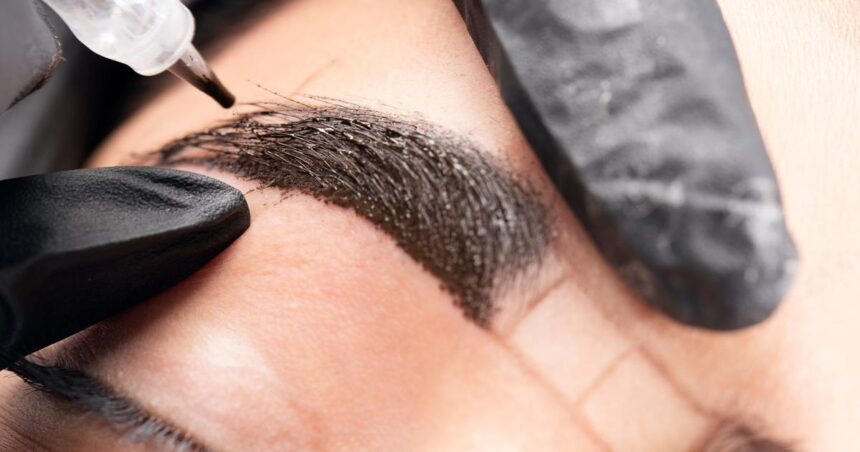Sealed bottles of tattoo and permanent makeup ink, including some marked as sterile, contained millions of potentially dangerous bacteria, according to new research by the US Food and Drug Administration.
“In light of our study results, we want to emphasize the importance of continuously monitoring these products to ensure the microbial safety of tattoo inks,” said Seong-Jae (Peter) Kim, a microbiologist staff fellow at the FDA’s National Center for Toxicological Research in Jefferson, Arkansas, in a statement. Kim is corresponding author of the July 2 report in the journal Applied and Environmental Microbiology.
Because the ink is injected deep into the skin where some bacteria can thrive, contaminated tattoo ink can cause infections and serious injuries, said study coauthor Linda Katz, the director of the FDA’s Office of Cosmetics and Colors.
People are also reading…
“Pathogens or other harmful substances in these inks can travel from the injection site through the blood and lymphatic systems to other parts of the body,” Katz said in an email.
When systemic spread occurs, bacteria can cause life-threatening complications such as endocarditis, a potentially deadly inflammation of the heart lining, or septic shock, which is the last and most severe stage of sepsis, the body’s extreme response to an infection that can result in multi-organ failure, Katz said.
If not quickly treated, “sepsis can rapidly lead to tissue damage, organ failure and death,” according to the US Centers for Disease Control and Prevention.
Other, more commonly reported symptoms of tattoo ink infections include injection-site rashes; impetigo, a highly contagious bacterial skin infection; erysipelas, a bright red and tender rash on the skin; and cellulitis, a deep infection of the skin that requires antibiotic treatment, according to Katz.
People with multiple or large tattoos are at higher risk from contaminated ink, Katz said, because larger tattoos increase the likelihood of exposure to microorganisms. Applying permanent makeup can also raise the risk of infection, she said.
“While both tattoos and permanent makeup carry risks if contaminated ink is used, permanent makeup applied around the eye area may pose a higher risk to consumers because microbes could enter the eye and may cause an infection,” Katz said.
Unfortunately, the study’s findings were not surprising, said John Swierk, an assistant professor of chemistry at Binghamton University, State University of New York, who has studied tattoo ink contamination. He was not involved in the new study.
“We know that contamination in tattoo inks is a common occurrence,” Swierk said in an email. “Part of the problem is that there is no agreed upon, industry-standard method for sterilizing inks. Our work and the current study really highlight the need for good, standardized manufacturing processes across the tattoo ink industry.”
The tattoo industry is increasingly working with regulatory bodies to ensure compliance with safety standards, said tattoo artist Selina Medina, director of research at the Alliance of Professional Tattooists, a nonprofit alliance of artists dedicated to promoting tattoo health and safety.
“Manufacturers are investing in advanced sterilization technologies and formulation advancements to improve their production environments to reduce the risk of contamination,” Medina said in an email.
“This includes using clean rooms and enhanced quality control processes to mitigate against problems like this.”
Bacterial counts should be zero
The latest study tested 75 samples of sealed tattoo and permanent makeup ink sold in the United States by 14 manufacturers that were not named by the FDA. Some of the samples were labeled as sterile.
Researchers found 26 samples from 10 manufacturers, or 35% of the sample set, had some degree of bacterial contamination. While most samples showed bacteria counts of less than 250 CFUs (colony-forming units) per gram, a few samples contained bacterial counts as high as 105, Katz said.
Each CFU represents the growth of a colony from a single microbe in a petri dish, so 10 to the fifth power equals 100,000 bacteria per gram.
Earlier studies by the FDA found 35% of unopened and sealed inks from US manufacturers had bacterial counts as high as 108 CFU, or 100 million bacteria per gram, Katz said.
That amount should be zero, said infectious disease expert Dr. Robert Schooley, a distinguished professor of medicine in the division of infectious diseases and global public health at the University of California, San Diego.
“The level of bacteria in materials that are injected into the skin or that come into contact with abraded or injured skin should be ‘none detected,’” said Schooley, who was not involved in the FDA study.
“The other issue here is that tattooing has also been associated with the transmission of viral infections including hepatitis C, hepatitis B and HIV,” said Schooley, who is also codirector of the Center for Innovative Phage Applications and Therapeutics, which uses one of bacteria’s ancient enemies, phages, to fight superbug infections.
“These (infections) were not studied in the FDA manuscript but the fact that so many of the inks failed bacterial sterility tests suggests that other organisms like viruses and fungi also can slip through the cracks,” he said.
How to protect yourself
Many certified tattoo artists are aware of the danger and may already take steps to avoid contamination, Medina said.
“Transparency with clients is vital. Artists should communicate openly about the steps they take to ensure ink safety and address any concerns clients may have,” Medina said.
“Before using new batches of ink, some artists and studios conduct their own testing or require proof of testing from suppliers. This can include microbial testing to detect potential contamination.”
In addition, tattoo artists can resterilize inks before application by using an autoclave, a machine that utilizes steam to apply high pressure and temperature to items to eliminate bacteria, Medina said.
The way an artist handles the ink while working on a tattoo is also critical, she said. For example, using the same gloves to touch a client and the ink bottle is a hazard that can lead to tattoo ink contamination.
Artists should ensure ink bottles are tightly sealed when not in use and stored in cool, dry locations away from direct sunlight to minimize the risk of contamination, Medina added.
Experts say the ultimate solution is for the tattoo and permanent ink manufacturing industry to be subject to regulations that require testing and certification before inks are allowed on the market.
“Tattoo inks are in the process of being regulated due to the Modernization of Cosmetics Regulation Act (of 2022) but much of that law dealing with tattoo inks has yet to be implemented,” Swierk said.
“We anticipate that MoCRA will be phased in over the next few years and that will represent the first serious regulation of tattoo inks in the US. Most of this will focus on good manufacturing processes and safety substantiation.”
The FDA released draft guidance for the tattoo industry in June 2023, which includes details on how manufacturers should conduct quality control measures, including sterilization.





